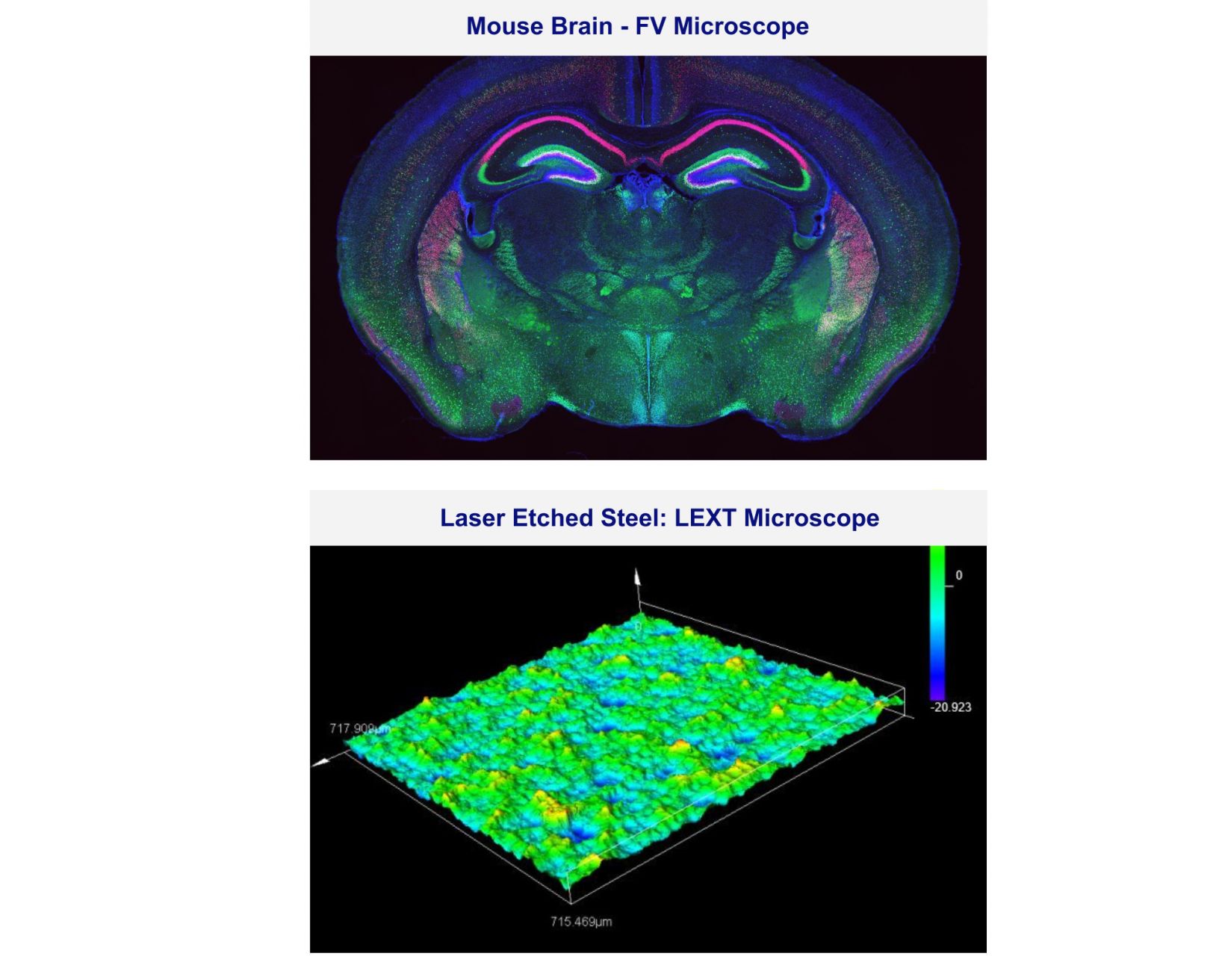Laser Scanning Microscopes
For Industrial and Life Science Applications
Life Science Solutions
was successfully added to your bookmarks
Maximum Compare Limit of 5 Items
Please adjust your selection to be no more than 5 items to compare at once
Industrial Solutions
Laser Scanning Microscope FAQs
What are the uses of a laser scanning microscope?
Laser scanning confocal microscopes are used in life science research across a broad range of live and fixed specimens for molecular and cellular anatomical, physiological, and biochemical studies. Their inherent ability to optically section light enables laser scanning microscopes to achieve accurate high-resolution and high-contrast reconstruction of 3D structures from a series of images obtained at different depths.
To learn more about the uses of confocal microscopy, visit our microscopy resource center.
How do point-scanning laser confocal microscopes work?
Confocal microscopy offers several advantages over conventional widefield optical microscopy, including the ability to control depth of field, elimination or reduction of background information away from the focal plane (high signal-to-noise ratio), and the capability to collect serial optical sections from thick specimens. The basic key to the confocal approach is the use of spatial filtering techniques to eliminate out-of-focus light or glare in specimens outside the immediate field of view.
A point-scanning laser confocal microscope creates optical sections of a specimen by scanning a focused laser spot point by point across a field of view. The microscope’s objective then focuses this light on the sample. The photons emitted from the fluorophores in the sample located at the focus point are collected by the objective and relayed back through the scanner, passing through a pinhole that is conjugate to the objective focal plane, causing only the in-focus photons to be detected by the photomultiplier tube. By imaging the photons at each point of the laser position, an image can be reconstructed pixel by pixel.
To learn more about confocal microscopy, visit our microscopy resource center.
What is multiphoton laser scanning microscopy?
Multiphoton microscopy is an excellent technique for deep imaging in thick specimens, especially during in vivo experiments. Strongly focused near-infrared laser pulses penetrate deeper into biological tissues than visible light, as near-infrared light experiences less absorption and scattering. For imaging, a pulsed laser is scanned across the specimen, typically using wavelengths from 700 to 1300 nm for excitation. Multiphoton excitation is inherently localized to the focal plane, thus reducing phototoxicity. More importantly, a confocal pinhole is not required for optical sectioning, so more light signal—including scattered fluorescence photons—can be collected. The results are bright, detailed 3D images from deep within thick specimens.
Discover the Olympus FVMPE-RS™ multiphoton laser scanning microscope.
How can I improve my image resolution with Olympus’ laser scanning microscopes?
Overall, resolution is significantly improved in confocal microscopy compared to traditional widefield microscopy techniques. Because resolution in laser scanning microscopy is dependent on the objective’s numerical aperture (NA), it is critical to use high NA objectives to achieve a high-resolution image. Olympus offers a suite of high NA objectives, including our X Line™ objectives, which offer high numerical aperture (NA), image flatness, and chromatic correction to improve image resolution over a larger field of view. For deep tissue imaging, our A Line™ silicone immersion objectives provide a close refractive index match to that of live cells, enabling brighter and higher resolution 3D imaging with minimal spherical aberration.
For increased resolution during deep imaging with our FVMPE-RS multiphoton system, TruResolution™ objectives have an automated correction collar that dynamically compensates for spherical aberration while maintaining accurate focus position. They automatically adjust at every plane of a volume image, delivering sharper and brighter 3D images at depth.
To remove image blur for clearer, sharper high-resolution images during image processing, Olympus has developed specialized TruSight™ 2D and 3D deconvolution algorithms for laser confocal and Olympus Super Resolution (OSR) images.
What is the optical resolution of Olympus’ laser scanning microscopes?
For studies requiring higher resolution, such as colocalization analysis, the Olympus Super Resolution (OSR) imaging module for the FV3000 system can acquire four fluorescent signals either sequentially or simultaneously with a lateral (X-Y) resolution of approximately 120 nm, nearly doubling the resolution of typical confocal microscopes.
Want to learn more about Olympus Super Resolution?
What is the maximum magnification of a laser scanning confocal microscope?
The FV3000 microscope from the FLUOVIEW™ series can be used with a variety of magnification objectives, from a low 1.25X objective to a high 150X objective, depending on the application. Low magnification objectives from 1.25X to 4X are suitable for capturing the structure of the entire tissue. To capture the morphology of the cells that make up the tissue, medium magnification objectives between 10X and 40X are used, and to capture the microstructure within the cells, high magnification objectives of 60X or higher are usually used. Optical zooming can further enhance the magnification of the image up to 50 times beyond the magnification level of the objective by decreasing the angle of the scanning mirror.
How much does a laser scanning confocal microscope cost?
Laser scanning microscopes can be built into a system according to your budget and application. If you have a limited target object that you want to observe, it is possible to limit the number of lasers, detectors, and types of objectives at an affordable price. It is also possible to upgrade the system by adding necessary units as your research objectives change and develop over time.
Contact your local Olympus representative to discuss our laser scanning confocal systems and get a quote.
Laser Scanning Microscopy Resource Videos
TruResolution Objectives
| Related Videos |
|---|
FV3000 Microscope in Cancer ResearchIn this video, Dr. Yuji Mishima of the Japanese Foundation for Cancer Research explains fluorescent imaging as a tool for research. | Related Videos |
Not Available in Your Country
Sorry, this page is not
available in your country.
